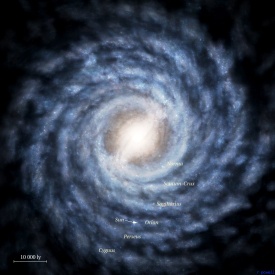Sol System
| Sol | |
 | |
|---|---|
| Designation: | G2V Sol |
| Galaxy: | Milky Way Galaxy |
| Classification: | G Class |
| Orbiting Bodies: | Mercury, Venus, Earth, Mars, Ceres (Dwarf), Jupiter, Saturn, Uranus, Neptune, Pluto (Dwarf), Haumea (Dwarf), Makemake (Dwarf), Eris (Dwarf) |
| Jump Points: | Unknown |
| Controlled By: | Unknown |
| Surveyed: | ~2,000 BCE - 2016 CE |
| Colonized: | Pre-Historic |
| Abandoned: | December 31st, 2037 |
The Sol System is the birthplace of Humanity. It contains 8 major planets (including Earth), in addition to a number of dwarf planets and a fair-sized asteroid belt.
It is located in the Orion arm of the Milky Way Galaxy.
History
The Sol System is home to Earth, the birthplace of humanity. The Sol System was the site of the War of Secession, which led to the system being abandoned by the victorious Initiative, who placed the system under a quarantine enforced by automated weapons platform.
Jump Points
| Name | Control | Average Travel Time | Notes |
| Unknown | Unknown | Unknown |
Knowledge of the jump points leading to and from the Sol System appear to have been deliberately purged from all navigational systems following the end of the War of Secession and the withdrawal of all active Initiative forces. Furthermore, despite extensive efforts on the part of the Church of Sol and other groups, no trail leading back to Sol has been located, suggesting countermeasures were put in place to ensure that the jump points to Sol were not rediscovered.
Planets & Moons
Inner Planets
The inner planets are the planets closest to Sol, but before the Asteroid Belt.
Mercury
The closest body to Sol, Mercury has an orbit around the sun of 88 days.
Venus
Venus is a "hothouse" planet, in that it's atmosphere is extremely toxic & corrosive, & traps much of the heat that reaches it, causing any equipment that manages to land to disintegrate rapidly.
Earth
Earth or Terra, as it's also known, is the 3rd planet from Sol, & the birthplace of Humanity. Following a series of wars on the planet, it has been largely abandoned and cut off from the galaxy at large.
Luna
Luna, or "The Moon" is Earth's only natural satellite. Humans first reached Luna in 1959 CE, when the Soviet Union]managed to launch a satellite into orbit. Humans first landed on the moon a decade later, in 1969 CE, when the United States of America's Apollo 11 successfully landed on the moon.
Mars
Mars, the "Red Planet", 4th from Sol, is named for the Roman god of war. It has two moons, Phobos & Deimos. It was considered Humanity's next destination following the exploration of Luna, but plans to colonize it were abandoned following the creation of the Point Singularity Drive.
Asteroid Belt
The Asteroid Belt roughly divides the Sol System is half, & is an area that private spaceflight companies someday hope to reach in order to mine out resources.
Ceres (Dwarf)
Ceres is considered a dwarf planet orbiting within the Asteroid Belt.
Outer Planets
The outer planets are the planets after the Asteroid Belt, but before the Trans-Neptunian Region, & Kuiper Belt.
Jupiter
Jupiter is a hydrogen-helium gas giant, roughly 2.5 times the mass of all the other planets & moons in the Sol System put together, or 318 times the mass of Earth.
At present, it has 67 confirmed moons.
Saturn
Saturn is perhaps most well-known for it's extensive ring system, comprised primarily of rock & dust.
At present, Saturn has 62 confirmed moons.
Uranus
Uranus, a unique planet in that it orbits at a more severe tilt than any other planet in the Sol System.
At present, Uranus has 27 known satellites.
Neptune
Neptune, named for the god of the sea.
At present, Neptune has 13 known satellites.
Trans-Neptunian Region
Pluto (Dwarf)
Initially considered a full planet, Pluto lost this status in 2006 CE with the formal adoption of a definition for "planet". Pluto is partially considered a binary planet, in that & it's "moon", Charon, orbit each other as well as the sun.